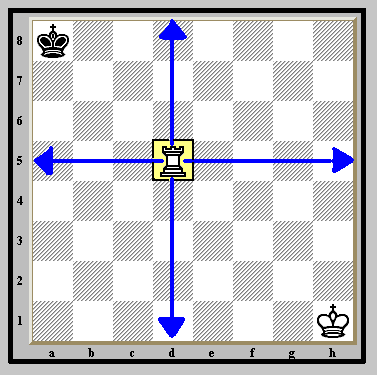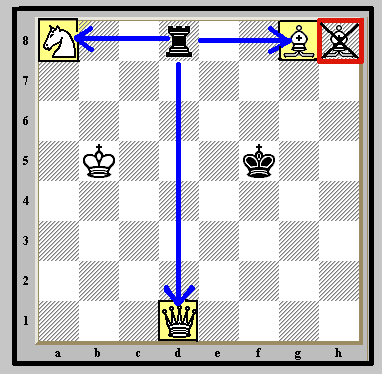All
the |
(Navigation bar
directly below.)
*******
© A.J. Goldsby, 2015.
(All rights reserved.)
****************
Click HERE
to see my
Chess Items.
****************
****************
Buy a book
from Amazon.com
(And help me out as well!)
****************
Click HERE
...
to see a list of the businesses that help to sponsor all of
my chess efforts.
"The Rook" in Chess
The Rook
(Or "A Real Straight-Shooter.")
Click HERE to return to my Training Page.
Click HERE to return to my HOME Page.
________________________________________________________________
Click HERE to go to another site where the basics of chess are covered.
Click
HERE
to go to another site where the basics
of how the pieces move are covered.
The
Rook is probably representative of the "Elephant" in warfare.
(If you have studied classical warfare, then you would know that Hannibal of
Carthage terrorized the Romans with his elephants. They mounted towers on the
back of these animals, and would place archers - or other personnel who utilized
projectile weapons - into these movable fortifications.)
The
Rook is the board equivalent of the classical battlefield Cannon.
It is definitely a LONG-RANGE
weapon!
Today, the Rook is the equivalent of "The Tank" of the modern battlefield.
Large, thick- skinned, and sometimes very hard to stop.
---> GM Maurice Ashley likens the Rook to, "A hungry Rhino on the charge!" <---
The Rook is the chess piece, at least when you are using the "Staunton Style" [standard] chess men, that looks like a tower. (Or an fence-post with an ashtray on top, according to one of my students. Some younger students have also commented that it looks like a cannon when you lay it on its side.)
The Rook moves straight up and down, and back and forth across the chessboard … in a straight line. It moves as many squares as it wants to without hopping over another piece. (The Knight is the only piece that can hop over other pieces.)
Now for a little picture:

Take a good look at the picture/diagram above.
This shows exactly the movement of a Rook. (Notice the blue arrows.)
Notice that the Rook controls 14 of the 64 squares. This is 22% of the entire playing field. This makes the Rook one of the more powerful pieces on the chess-board.
Remember, the Rook – like all other chess pieces, (except for the pawn) – moves exactly the same way that it captures.
Think of a cannon and straight lines, and you have the way that the Rook will move on the chessboard.

Take a look at the above picture/diagram carefully.
(Again, notice the blue arrows. This shows the basic movement
and capturing powers of the Rook.)
***
The Black Rook on d8 can capture any of the following pieces:
#1.) The White
Knight on a8;
#2.) The White Queen on d1;
#3.) Or the White Bishop on g8.
(Notice I have high-lighted these squares in yellow.)
***
NOTE: The Black Rook can NOT capture the White Bishop on h8,
(on this move, anyway);
as this would mean that The Black Rook had JUMPED OVER
the White Bishop on g8.
(Notice the red "X" overlaying the square.)
IF the Black Rook on d8 captured the White Bishop on g8
on
the first move; then
(and only then) would it be able to capture the
White Bishop on h8 on the second move!
(That is also to assume that White does not move the Bishop on h8 in the interim!)
Properties of the Rook:
(Just read this. Don't worry too much about remembering it right now. It's enough that it will be buried in your subconscious.)
# 1.) The Rook is immobile at the start of the game. It is often sacrificed for tempo in an attack. It takes many moves before the Rook can really make its presence felt in a chess game.
# 2.) The Rook needs open files (lines) to be effective. The Rook is also dangerous in a position where the Rook can be transferred (called a 'Rook Luft') from one side of the board to the other side of the board on an open rank. (Even GM's occasionally miss this type of move!)
# 3.) The Rook LOVES to go down and eat up all of his opponent's pawns on the opponent's second row. This is why a Rook, eating too much, is sometimes known as a, "Pig on the Seventh Rank."
#
4.) The Rook is probably "Public Enemy, Number # 1" to the
opposing King. One of the most common checkmates an unwary or very inexperienced
player will fall into is letting a piece mate him on his (or her) first row when
the player's own pawns block the escape of the King. This is known as a "Back-Rank
Mate," and is probably the most common mating pattern!!
And The Rook is the most likely culprit!
#
5.) The Rook is most effective when it is BEHIND a pawn.
(Behind your own pawns and also behind your opponents pawns. This way, no matter
how far down the board an enemy pawn gets, your Rook will always be attacking
it. Just simple, common sense.)
#
6.) The Rook is normally GREATLY superior to a
single Knight or Bishop. (This is because a Rook covers
so many more squares than these other two pieces do
individually. This is why a Rook is worth more than a Knight or
a Bishop on "The Table of Material Value.") The Rook can often be
superior to TWO minor pieces in situations where the
primary emphasis is on mobility. Yet normally, The Rook (+ 1 Pawn) is VASTLY
inferior to a Knight AND a Bishop. (Even though the 'Points Scale' is the
same!) This is because of the simple military truth that TWO
fighting units are nearly always superior to ONE! (Simple common sense would tell you that.)
Yet the beginner and Novice will often make this trade without a thought to how they have disturbed the basic balances of the game.
#
7.) The Rook is a clumsy piece in positions where there are few usable open
lines available to it.
In these situations, A Rook may be vastly inferior to a well-placed Knight
or Bishop.
#
8.) The Rook works best in cooperation with other pieces. [ This
maybe true of all the pieces. :) ]
Two of the most effective
Rook combinations are a Rook on an open file, working WITH a Bishop on an open
diagonal; and two Rooks pushing down the same file TOGETHER.
(This is known as a "battery.")
The Rook is a pretty simple piece. Straight lines. Files and
Ranks. Up and down,
back and forth, right to left, left to right. It captures
just like it moves.
And that’s pretty much it for the Rook.
***
Copyright (c) LM A.J. Goldsby I
Copyright (c) A.J. Goldsby, 1975-2014.
Copyright © A.J. Goldsby, 2015. All rights reserved.
***
(Page last updated: December 23rd, 2003. Last edit or save on: February 12, 2015 01:43 PM .)
That concludes our study of the Rook.
Click HERE to go to the next page, "The Bishop" in Chess.
